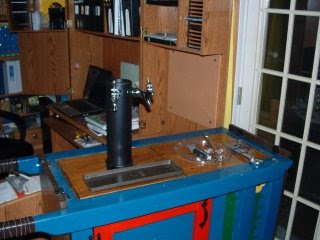When I started seriously getting into brewing, I began scouring every resource I could find for tips on how to improve my brews. The tips I found seemed pretty simple–use fresh ingredients; pay attention to fermentation temperatures; “relax, don’t worry;” that sort of thing–but I quickly noticed that they all seemed pretty uniform. No matter where I went, everybody had the same advice. While the “normal” tips out there will certainly help improve your brewing, I’ve compiled a list of a few more “off-the-wall” tips I have collected on my own. Without further ado:
- Learn how to taste beer. Not how to drink beer, but how to taste it, the way that serious wine people do “wine tastings,” but without the pretension. Train your palate. If you can’t recognize that a given beer is bad (or a bad example of style), compared to a different one that is good, then anything you do to “improve” your beer will come up short. More importantly, if you can’t tell why something is bad, you won’t be as well-positioned to critically taste your own brews, or improve them. Going through formal Cicerone training is a formal way of doing this, but it’s a bit costly. A simpler, more informal way of doing it is to organize beer tastings with small groups. Take time to try the beers at their “intended” temperatures, and sip them as they warm up. Discuss what you’re tasting; talk about what you’d like to taste in the beers, and talk through how you might get there.
- Try commercial examples of lots of styles. Try lots of commercial examples. Try multiple versions of styles. Try them from as close to the source as possible–and try them “aged,” or even slightly stale. Learn what styles you like, and what you don’t like. Learn why, and how to explain why. This will help you focus your brewing–there’s no reason to brew Bourbon Imperial Double-Stouts, if you don’t like them. Likewise, it will help you be able to recommend brews to others. (If you don’t know it’s out there, or don’t know what it’s like, you can’t recommend it.)
- Join a club, group, or find a brewing mentor. Good places to go for this include your local homebrew store. I’ve heard stories of unfriendly ones, but I’ve never actually been to one; usually, all of the employees are happy to help, however they can. Find your local homebrew club: if there’s not a small one locally, there’s bound to be a larger one that covers your region. A great place to find your local store or club is the American Homebrewers Association (there’s a link in the sidebar to join); I also recommend getting a membership, both for the online resources, and for the discounts on brewing books, as well as Zymurgy magazine. Go online: there are several forums, where you can get informal advice and mentorship from some very experienced people. (My favorite, at present, is HomeBrewTalk.) Having these sorts of connections will provide good discussions of styles, techniques, and equipment; it can provide exposure to more examples of styles; you can get access to more resources, and possible use of equipment. Most importantly, it’s a way to get feedback for your own brews.
- Brew a lot. Think of it as the beer equivalent to the “10,000-hour rule.” If you don’t brew frequently, it’ll be like a “new experience” every time you go to brew. You’ll never really build your confidence, or your knowledge of your equipment. Having lots of experience bumps up the chances of things going smoothly–and increases your “library of tricks” to fix when things go poorly. A corollary of this rule is “Be willing to dump a batch.” You can’t hit a home run at every at-bat. And sometimes things to irreparably wrong. You’ll probably not have to dump many–I can count mine on the fingers of one hand–but you’ll likely have to dump one at some point along the way.
- Keep copious notes. Notes on your brews. Yes, the recipes, but more importantly on how the brew went and what happened. What went well, what went poorly. Document the recipes, as well as (especially) on-the-fly changes, because the one time you don’t, you’ll brew up the best thing you’ve ever tasted, and you won’t be able to remember how, or to recreate it. When things go really wrong, you’ll have a written record to assist in fixing the issue later. When the brew is done, add tasting notes on it, to figure out whether to improve it next time, and how, or even to decide if you want this to be a “house brew.” I’ve got my so-called “Little Black Book,” in which I record all of these things; I can look back on 14+ years of batches for inspiration, corrections, or just to reminisce.
- Learn your ingredients. Know what goes into your beers, and how you can change the brew by varying the use of those ingredients. Taste things, at every step of the way. Chew on some grains. Take deep whiffs of hops. Try a drop of different yeasts. Taste the wort–first runnings, last runnings, post-boil. Take samples of the beer during fermentation, and taste them. Try your batch before it’s carbed. This will give you some baselines for what a “good” batch/process looks like, so you can recognize when things go off the rails. I’m also fond of the so-called “SMaSH” beers, where you use a single base malt and a single hop variety. (“SMaSH” stands for just that: Single Malt and Single Hop.) You can use these to taste individual ingredients–and you can do them in series, changing one ingredient each time, to compare different ones. Do a series with different base malts (using the same recipe, up to a given gravity, with a fixed hop schedule). Then do a series with the same base malt, changing the hop variety each time. Do a series of the same recipe, using a different yeast. Only change one ingredient at a time, to get fair comparisons. And, importantly, take notes.
- Know your equipment. If you change things up every time, you’ll change your beer somewhat, even using the same recipe. When starting off, you’ll be building up to your “final system,” possibly for a long time. (While I’ve used the same setup for years, I’m still planning improvements.) But try to stick to a basic setup as much as possible. If you maintain it & learn it, you’ll be able to adjust recipes based on your equipment–your batch efficiency will be unique, and how you run the brew will change. (For instance, my setup does not lend itself well to decoctions–so I avoid recipes with decoction mashes, or adjust them to be “normal” infusion mashes.) Also, you can calibrate your equipment: set up volume markers; learn how much dead space various vessels have; learn your typical boil-off rates, and the like. If you’ve got one, and I suggest you acquire one, input this data into your favorite brewing software–this will help when formulating your own recipes.
Those are probably the biggest tips that I’ve got, beyond the basics. If you’ve got more tips, please let us know in the comments!


